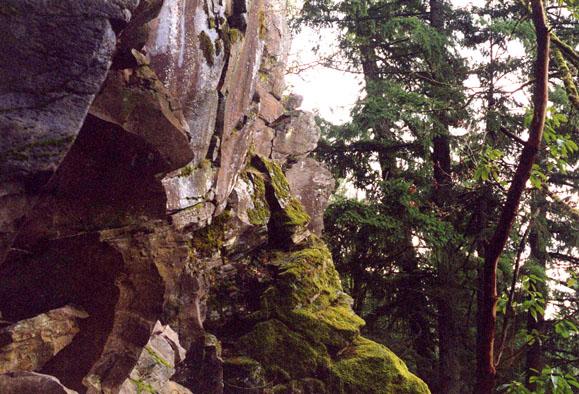
POLICY SUMMARY:
land use
Home
About the FWOC
Join the FWOC
Member Organizations
Adopted Resolutions
Outdoors West
Officers
Current List of Conservation Developments with Bush Administration
History
Policy Summary
Convention Schedule
Related Links
Site Map

Madrone Wall, Oregon
FEDERATION OF WESTERN OUTDOOR CLUBS
next >>
States should enact legislation establishing statewide planning goals for land use, which should be reflected in land-use plans adopted by local jurisdictions. Such goals should combat unplanned growth, wasteful and uncoordinated development, sprawl, destabilization of established communities, and divisive conflicts over the future of communities. They should also guard against the loss of farm and forest lands, declines in fish populations, loss of valuable wetlands, loss of ecological diversity, and polluted air and water. Efforts along these lines in Washington state were supported in 1990. [Res. 25, 1990]
Urban growth boundaries should be adopted by cities and counties in the west. They will provide an officially mapped line that clearly delineates land zoned for urbanization and that zoned for conservation, agriculture and open space. Such boundaries discourage land speculation and provide a tool to control sprawl, while protecting open space. They create incentives for compact growth. [Res. 27, 2003]
Public lands to the north of Reno (up to 30 miles north) should not be disposed of on a wholesale basis to facilitate expand urban development in this area. This land is needed for wildlife and is too valuable as open space and wild land. [Res. 1, 2006]
Because open space is critical in places such as southern Washoe County in Nevada to provide habitat for wildlife, to protect water resources, vegetation, and to provide opportunities for recreation and ecotourism, it is important that Washoe County proceed to study its open space needs, particularly in the southern part of the county. [Res. 11, 2007]
Urban communities and counties should take action to identify appropriate open spaces and create a process for acquiring them before such spaces are preempted by development. Neighborhood parks and green, outdoor spaces provide needed opportunities for recreation and relaxation, as well as a means to overcome a sense of isolation. Rapid population growth now makes such action imperative. [Res. 8, 1996]
To curb sprawl and the preemption of habitat, there must be less dependence on cars and trucks and less pressure for enlarging highways and providing more parking lots. A greater percentage of gas taxes must be used for public transportation. More funds must be provided to improve public transit and rapid transit. Better use must be made of under-utilized rail lines, and major portions of long-haul freight must be shifted from highways to more efficient railroads. New development projects should not be planned that are not accessible to non-motorists. Outdoor clubs should plan activities with the use of public transportation. [Res. 7, 1997]
A transparent, public process should be used to chart the future of the 270,000 acre Tejon Ranch between Bakersfield and Los Angeles. Many environmentally important resources exist on the tract, including key habitat and 57 listed and sensitive plant and animal species. These should be inventoried, in a scientifically valid way, before decisions are made about the future of the tract. Information is needed about the habitat needs of species fond there that require large areas. Clear, objective criteria must be used to make decisions. Public input must be invited. All or large parts of the area should be put in public ownership. [Res. 28, 2003] Because scientific evidence now exists to demonstrate that this area is a hotspot for biological diversity (including for the endangered California condor), and its development could exacerbate urban sprawl, 245,000 acres there should be acquired for protection to safeguard its habitat, with sensible development allowed on the remainder of the ranch. [Res. 5, 2006] The time has come to make the Tejon Ranch either a national or state park, or accord it to some other appropriate designation, to protect its unique biodiversity (it is one of the world's 25 biological "hotspots." [Res. 9, 2007]
Because of its sensitivity as an important trout stream, which should be considered for addition to the federal systems of Wild and Scenic Rivers, a major inholding on Upper Deep Creek in California's San Barnardino National Forest should not be developed with a subdivision. [Res. 2, 1995]
The ski development at Mt. Hood Meadows in Oregon should not be expanded as a year-round resort because of the threat that such expansion would pose to alpine meadows, glacial streams and wetlands (the summer impact would exceed that in the winter). [Res. 14, 1998]
Major ski resorts should not be built in the relatively undeveloped Methow Valley of eastern Washington state because of the threat they pose to the area's wildlife habitat and quality of life, including low-impact recreational opportunity. [Res. 34, 1991]
The forests of the foothills overlooking Puget Sound must not be converted to urban uses. Various methods should be employed to assure that they remain in forest. If they are managed as timber, standards should be improved to better protect fish and wildlife. [Res. 31, 1999]
next >>